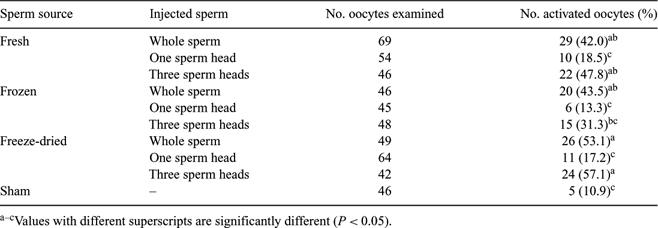376 EFFECT OF SPERM TREATMENT ON THE ABILITY TO ACTIVATE OOCYTES AFTER ICSI IN PIGS
M. Nakai A , N. Kashiwazaki B , N. Maedomari A B , M. Ozawa A , J. Noguchi A , H. Kaneko A and K. Kikuchi AA National Institute of Agrobiological Sciences, Tsukuba, Ibaraki 305-8602, Japan
B Graduate School, Azabu University, Sagamihara, Kanagawa 229-8501, Japan
Reproduction, Fertility and Development 19(1) 303-304 https://doi.org/10.1071/RDv19n1Ab376
Submitted: 12 October 2006 Accepted: 12 October 2006 Published: 12 December 2006
Abstract
During fertilization, sperm penetration (gamete membrane fusion and exposure of sperm cytoplasm) allows oocyte activation (resumption of oocyte meiosis, pronuclear formation, etc.) by inducing an elevation of the intracellular free Ca2+ concentration. So a spermatozoon ought to be able to fully activate an oocyte. However, in pig ICSI oocytes, although a spermatozoon is injected successfully into ooplasm, complete activation is deficient in some of the oocytes. A variety of sperm pre-treatments before ICSI have been reported; however, there is a possibility that the treatment affects the ability to activate oocytes after the injection. We examined the effect of sperm treatments (freezing, freeze-drying, and sonication) on the ability to activate oocytes. Ejaculated boar semen was centrifuged (10 min, 600g) and the supernatant was discarded. The sperm pellet was resuspended in Modena solution (Weitze 1991 Reprod. Domest. Anim. (Suppl. 1), 231–253). The sperm were then treated with or without sonication for 10 s (fresh whole and sonicated sperm, respectively). The freezing of sperm was carried out as was described (Kikuchi et al. 1998 Theriogenology 50, 615–623). Frozen–thawed spermatozoa were then treated with or without sonication (frozen–thawed sonicated and whole sperm, respectively). The fresh whole and sonicated sperm were subjected to a freeze-drying system and the sperm were then re-hydrated (freeze-dried whole and sonicated sperm, respectively). A whole sperm or 1 or 3 sonicated sperm heads were then injected into in vitro-matured oocytes, as described previously (Nakai et al. 2003 Biol. Reprod. 68, 1003–1008; 2006 Reproduction 131, 603–611). Sham injection was also performed. No artificial stimulation was added to the injected oocytes. The oocytes with more than one pronucleus(i) at 10 h after the injection were defined as being activated. As shown in Table 1, the rates of activated oocytes after injection of one sonicated head or sham injection were significantly lower than those of the oocytes injected with whole sperm or 3 sonicated sperm heads in each sperm source (P < 0.05 by ANOVA and Duncan's multiple range test). Furthermore, the rates of activated oocytes for each injection category were not different among the 3 sperm sources. These results suggest that sonication before ICSI may reduce the quantity of activation-inducing sperm factor. It is also suggested that sperm pre-treatment such as freezing or freeze-drying does not affect the ability for oocyte activation.

|


